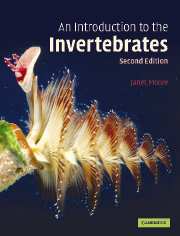Book contents
- Frontmatter
- Contents
- List of boxes
- Preface
- Acknowledgements
- Illustration acknowledgements
- Chapter 1 The process of evolution: natural selection
- Chapter 2 The pattern of evolution: methods of investigation
- Chapter 3 Porifera
- Chapter 4 Cnidaria
- Chapter 5 On being a worm
- Chapter 6 Platyhelminthes and Acoelomorpha
- Chapter 7 Nemertea
- Chapter 8 Nematoda
- Chapter 9 Annelida
- Chapter 10 Mollusca: general and Gastropoda
- Chapter 11 Mollusca: Bivalvia and Cephalopoda
- Chapter 12 Arthropoda: general
- Chapter 13 Crustacea
- Chapter 14 Chelicerata and Myriapoda
- Chapter 15 Insecta
- Chapter 16 Animals with lophophores
- Chapter 17 Echinodermata
- Chapter 18 Invertebrate Chordata and Hemichordata
- Chapter 19 Development
- Chapter 20 Invertebrate evolutionary history
- Further reading
- Glossary
- Index
Chapter 9 - Annelida
Published online by Cambridge University Press: 05 September 2012
- Frontmatter
- Contents
- List of boxes
- Preface
- Acknowledgements
- Illustration acknowledgements
- Chapter 1 The process of evolution: natural selection
- Chapter 2 The pattern of evolution: methods of investigation
- Chapter 3 Porifera
- Chapter 4 Cnidaria
- Chapter 5 On being a worm
- Chapter 6 Platyhelminthes and Acoelomorpha
- Chapter 7 Nemertea
- Chapter 8 Nematoda
- Chapter 9 Annelida
- Chapter 10 Mollusca: general and Gastropoda
- Chapter 11 Mollusca: Bivalvia and Cephalopoda
- Chapter 12 Arthropoda: general
- Chapter 13 Crustacea
- Chapter 14 Chelicerata and Myriapoda
- Chapter 15 Insecta
- Chapter 16 Animals with lophophores
- Chapter 17 Echinodermata
- Chapter 18 Invertebrate Chordata and Hemichordata
- Chapter 19 Development
- Chapter 20 Invertebrate evolutionary history
- Further reading
- Glossary
- Index
Summary
Most of the 15 000 known species of annelid worms live in the sea, crawling under rocks on the shore and sea bottom, freely swimming or seeking protection from predators in burrows or tubes. Freshwater and terrestrial annelid radiation has been small except for the earthworms, which are outstandingly successful, and the leeches, which are widespread specialised suctorial predators. Annelids vary in length from 1 mm between sand grains to 3 metres in some Australasian earthworms.
Annelid worms are coelomates with metameric segmentation. The annelid coelom is a large fluid-filled body cavity surrounded by mesoderm, providing an efficient hydrostatic skeleton. Metamerism is the serial repetition of similar parts along the length of an animal, manifested primarily in the separation of the mesoderm into segmental blocks of muscle. In annelids there are usually internal partitions (septa) between the segments. Both the coelom and metamerism improve the effectiveness of muscle contractions, so that active locomotion can be much faster than in acoelomate animals. At the same time these advances demand greater complexity: when an extensive coelom separates the inner and outer tissues, a transport system is required and more elaborate respiratory and excretory organs may need to develop. This complexity then allows more structural differentiation and an increase in size.
Information
- Type
- Chapter
- Information
- An Introduction to the Invertebrates , pp. 101 - 119Publisher: Cambridge University PressPrint publication year: 2006
